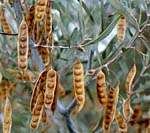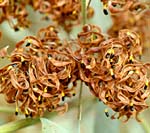|
|
|
|
Acacia seed as a source of human food has been a subject of increasing interest and research in recent years. Much of this work is based on an understanding of traditional Aboriginal use of many of these species (Thomson, 1992; Latz, 1995; Maslin et al., 1998). The overall nutritional value of certain Australian dry-zone Acacia seeds is typically high, reflecting their protein, fat and carbohydrate content, and the seeds contain no or low levels of toxic or anti-nutritional compounds (Brand & Maggiore, 1992; Harwood, 1994; Harwood et al., 1999).
The seeds of tropical arid zone species, such as A. elachantha (Kalkardi), A. thomsonii (Thomson's Wattle), A. tumida (Pindan Wattle) and particularly A. colei (Cole's Wattle), are showing promise as a new human food source in semi-arid regions of the Sahel, West Africa. Research has revealed that these fast-growing species produce large crops of palatable, nutritious seeds (Thomson, 1992; Harwood, 1994). They are easy to establish in the field, show excellent survival and produce heavy seed crops within two years of planting. The seeds are readily processed using local technology and the ground flour has been incorporated into local recipes. Positive results from dietary trials and nutritional studies indicate that seed flour from these species could extend food supplies by up to 25 percent in this region (Harwood et al., 1999). These species were originally introduced into Africa for fuelwood, windbreaks and amenity plantings (Cossalter, 1987) and they continue to be important resources in these roles.
In Australia, Acacia seed as a human food is used in relatively small quantities in the developing bushfood industry; most of this seed is collected from the wild, either by commercial seed collectors or by Aboriginal communities. Maslin et al. (1998) examined the potential for expanded production and use of Acacia seed for human consumption in southern Australia. Of the 47 species identified as having potential, A. victoriae (Gundabluey) (currently the most important wattle species in the Australian bushfood industry) and its close relative A. murrayana (Colony Wattle) appear to be the best prospects. Ground roasted acacia seeds are mainly used for flavouring sauces and ice cream, and in breads, pasta and biscuits. The low-glycaemic index of acacia seed also suggests potential in the diet of diabetics. While acacias may ultimately prove successful for producing commercial quantities of seed for human food, currently there is very little information on the nutritional and toxicological characteristics of their seeds.
Some useful links
Article on the nutritional value of Acacia Seeds.
Australian Native Plant Food Industry (ANPFI)
Provides industry information relevant to the use of Acacia in the Australian native plant food industry. This site is produced by the ANPFI and funded by Rural Industries Research and Development Corporation.
Centre for New Crops & Plant Products
Essay on the ethnobotany and the potential of Acacia as a human food crop by Lister et al.
Seed Saviours. An article on traditional food use of wattles, and prospects for the future.
Developing Australian Acacias as a human food for the Sahel . Paper by Chris Harwood, Tony Rinaudo and Steve Adewusi.
Acacia in Australia: Ethnobotany and Potential Food Crop by Peter Lister et al.
Rural Industries Research and Development Corporation
Wattle Seed Production in Low Rainfall Areas. Report to RIRDC by Sarah Simpson and Peter Chudleigh. See also Proceedings of a Workshop to Assess Prospects and Develop R&D Priorities for a Wattle Seed Industry at this same site.
Session 3 of this Symposium was devoted to ‘Seed for human food’.
References
Brand, J.C. & Maggiore, P. (1992), The nutritional composition of Australian Acacia seeds, in A.P.N.House & C.E.Harwood (eds), Australian Dry-zone Acacias for Human Food, pp. 54-67. Australian Tree Seed Centre, CSIRO Division of Forestry, Canberra.
Cossalter, C. (1987), Introducing Australian acacias in dry, tropical Africa, in J.W.Turnbull (ed.), Australian Acacias in Developing Countries. ACIAR Proceedings No.16, pp.118-125. Australian Centre for International Agricultural Research, Canberra.
Harwood, C.E. (1994), Human food potential of the seeds of some Australian dry-zone Acacia species, J. Arid Environm. 27: 27-35.
Harwood, C.E., Rinaudo, T. & Adewusi, S. (1999), Developing Australian acacia seeds as a human food for the Sahel, Unasylva 196: 57-64.
Latz, P.K. (1995), Bushfires and Bushtuckers: Aboriginal Plant Use in Central Australia. IAD Press: Alice Springs.
Maslin, B.R., Thomson, L.A.J., McDonald, M.W. and Hamilton-Brown, S. (1998). Edible wattle seeds of southern Australia. A review of species for use in semi-arid regions. 108 pp. (CSIRO: Australia.). This book is available for purchase from CSIRO Publishing.
Thomson, L.A.J. (1992), Australia's subtropical dry-zone Acacia species with human food potential, in A.P.N.House & C.E.Harwood (eds), Australian Dry-zone Acacias for Human Food. Proceedings of a workshop held at Glen Helen, Northern Territory, Australia, 7-10 August 1991, pp. 74-81. CSIRO Division of Forestry, Canberra.


